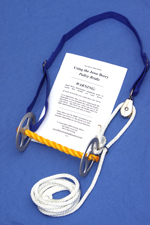Does Your Horse Crossfire?
Here’s trainer Andy Curry talking about crossfire:
Months ago I interviewed pro horse
trainer Danie Hewlett.
She and her husband Doug train Reining
horses.
While talking she pointed out how horses oughtt to be good ‘leaded’.
That’s not ‘led-ed’,…it’s pronounced
‘leed-ed’ – like you would ‘lead’ a horse.
Anyway, after a horse is fairly broke
it simply boils down to whether the horse has physical and mental
capabilities to to do reining maneuvers.
But the #1 thing says Danie, is the horse should be ‘leaded’.
That means that when the horse runs
small and big circles, he should stay true to his lead.
Danie noted that lots of horses cannot
run fast without falling out of it’s lead.
A horse in the correct lead has his
inside front and back feet leading.
If the horse falls out of his lead, his hind end goes out
and suddenly his lead has shifted.
This is called a ‘Crossfire’.
When Danie and her husband begin Reining training with horses,
that’s the first thing they look at.
If they’re dealing with a horse that can’t stay in it’s lead,
then they say, ‘Next’.
Most horse owners don’t have that luxury.
But the Hewletts do this for a living and it doesn’t make
sense for them to train one to do it.
Why?
Because they want the horse to stay in his lead naturally.
Danie says there are too many horses that do it naturally
and there’s no sense in training a horse to do it.
In Reining competitions, every time a horse goes out of lead
a point is deducted. So from a competition stand point, it
doesn’t make sense to work with a horse that does that.
From the Hewlett’s point of view, it makes sense because it’s
how they make their living.
But what if you have a horse that falls out of his lead?
Should you sell him and get a different horse?
Naw…unless you want to.
If you’re going to train them for Reining competitions
then you might – otherwise…no.
But I’ll tell you this.
If you don’t know much about Reining
you should look into it because there’s a lot you can learn
about getting your horse to do different things.
For example, when we filmed Danie and Doug for the Reining
DVD’s, they showed how to evaluate a horse.
Danie started off with some lungeing,
explained what she was looking for, etc.
It’s good stuff to know if you’re going to stay in the horse
world – even if you’re not going to train professionally.
All horse owners have a responsibility
to themselves, their horses, and those around them to
know all they can.
This horse thing can get perplexing at
times and the more you know, the better off you are.
Thus, if you want to know more about the Hewletts and their
Reining info, click on the following:
Danie and Doug Hewlett Reining DVD
Here’s an example why it’s good to know this stuff.
Did you know some horses have trouble giving their chin?
Do you know why?
It’s because their neck is built such that it’s hard for
them to do.
Kinda like a muscular guy would have trouble scratching his
opposite shoulder because his chest is so big and he can’t
cross him arm over.
In a way…it’s like that.
A horse that can’t give his chin very good may choke himself.
Then it will always be a fight – and that won’t work.
But if you didn’t know what I just told you…how long would
you have fought it and suffered frustration before you got fed
up and sold your horse?
Danie and Doug Hewlett Reining DVD
Ok.. stay safe around your horses…
Charlie
==========================================================
Are You Ashamed of Your Horse’s Behavior?
Jesse Beery’s 8 Volume Course on Horsemanship has been
successfully used by thousands of horse owners to overcome
even the worst bad habits and problems.
Get it, read it, apply the methods yourself.
Each day is an opportunity to improve.
Each day you work with your horse and start overcoming the
problems brings you closer to the point where you don’t
have to be frustrated or fear your horse.
Start enjoying your horse!
Click on the link below and get your copy of the Jesse Beery
training course now:


